In this content you’ll learn:
Key Takeaways
- The top ten reasons your lawn mower could be sputtering are:
- A dirty air filter
- Clogged fuel system
- Spark plug issues
- Carburetor problems
- Low fuel
- Fuel contaminated with water
- Cutting difficult grass
- Exhaust system blockages
- Failure to keep up with maintenance
- Weak battery
- Some issues require a quick DIY fix, while others need the help of a professional.
- The best way to prevent these issues is to keep up with essential maintenance, which you can use a calendar to help track.
Your lawn mower is sputtering or can sputter for many reasons. To help, we’ve listed the top ten reasons below and what to do for each one. So, what are those reasons, and what do you need to do to fix them?
Top Ten Reasons Your Lawn Mower Is Sputtering (And What To Do For Each)
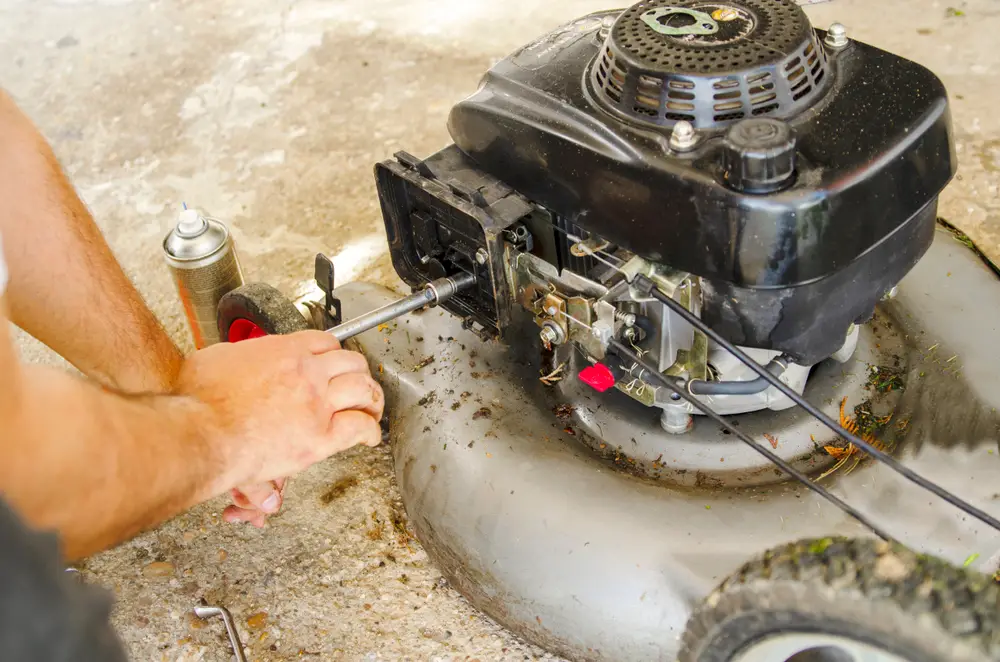
Some of the following problems are minor issues. In those cases, you’ll likely be able to fix them yourself. In other cases, you’ll need the help of a certified mechanic.
Also, after you or a professional completes the maintenance, test your lawn mower to see if it runs better.
With that in mind, here are the top ten reasons your lawn mower is sputtering (and what you can do in each case).
Follow Proper Safety Precautions
Always follow proper safety precautions before performing any lawn mower maintenance.
To start, gather the following items:
Keeping these on at all times is essential. Also, pay attention to your lawn mower as you work on it. If you notice anything out of the ordinary or dangerous, stop immediately and contact a professional.
Finally, perform all maintenance on level ground and in a well-ventilated space. Also, chock the wheels so your lawn mower won’t roll.
1 – Dirty Air Filter
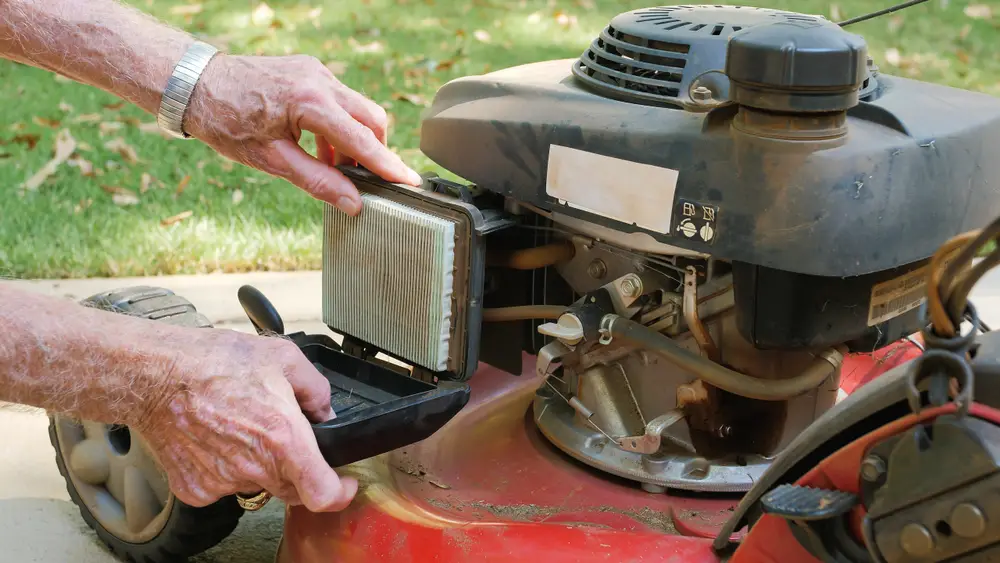
Your lawn mower’s air filter traps dust and dirt particles from the air while you mow, preventing them from reaching the carburetor and engine. Without an air filter, these particles stop the airflow, choking out the lawn mower and causing it to sputter.
What To Do
You can find your air filter on the side of the engine in a compartment with a plastic cover and a single nut (usually wing-shaped).
Once you locate the air filter compartment, remove the cover and take out the filter to inspect it. You’ll usually want to replace the air filter, but if you can’t afford one, you can clean it with an air compressor blower until the dirt and debris are gone.
When finished, clean the bottom compartment area with a damp rag, careful not to drop anything into the carburetor below.
Once clean, replace the air filter and cover.
2 – Clogged Fuel System
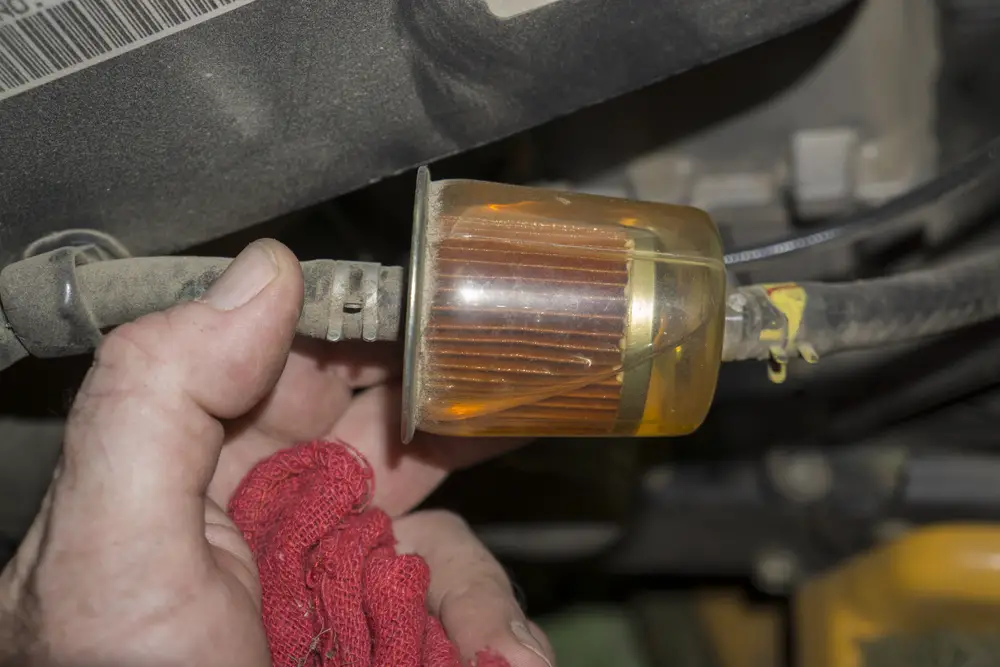
Your lawn mower’s fuel system runs from the fuel tank through the fuel lines and fuel filter to the carburetor and engine. Fuel will struggle to reach these if debris or gunk obstructs them, causing your lawn mower to sputter.
This can happen due to a worn-out or clogged fuel filter.
What To Do
Locate your lawn mower’s fuel filter by looking for its connections on the fuel hoses, which lead from the fuel tank to the engine. The connections will either be a ring with a screw or V-shaped rings. Use a flathead screwdriver for the ring and screw and needlenose pliers for the V-shaped rings.
Remove the fuel filter once you’ve pulled the rings back about two inches. Replace it with a new one, taking care that it faces the same direction. Some fuel will leak during this process, so use gloves and clean it up with a rag.
Pull the rings back to their original location (marked with indentations). For the V-shaped rings, once you release them, they will automatically retighten. For the screw ring, you’ll need to hold the ring in the right spot and screw it tight.
Use fuel treatment or stabilizer after changing the filter (there are lots of great options), following the bottle’s instructions.
3 – Spark Plug Issues
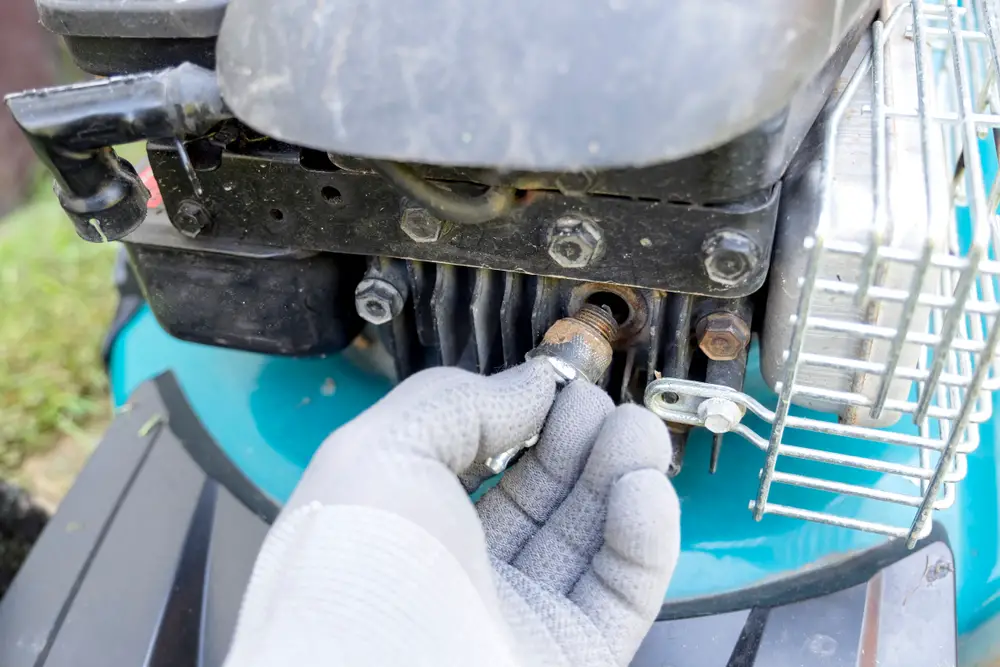
Spark plugs fire sparks of electricity into the engine chambers, allowing combustion so the engine can work. If the spark plug is dirty, damaged, or misfiring for another reason, your lawn mower will sputter.
What To Do
Locate your lawn mower’s spark plug at the front of the engine. You’ll see an open hole in the housing with a single wire. Remove the wire, and you’ll see the spark plug.
Use a ⅝” deep socket and ratchet to unscrew the spark plug carefully.
Take note of the L-shaped piece at the end of the spark plug. You will see a small gap between the spark plug’s point and this piece. Use a gap tester to measure this gap and see if it matches your owner’s manual’s measurement.
A large gap means you’ll need to replace it. Check the new spark plug’s gap to ensure it’s correct.
Screw the spark plug into the spark plug hole by hand until it is snug. Use the socket and ratchet to tighten it the rest of the way. Press the wire back down onto the spark plug’s end until you hear a click.
You’ll also need to replace your spark plug if it’s damaged. If it’s dirty, you can try cleaning it first.
4 – Carburetor Problems
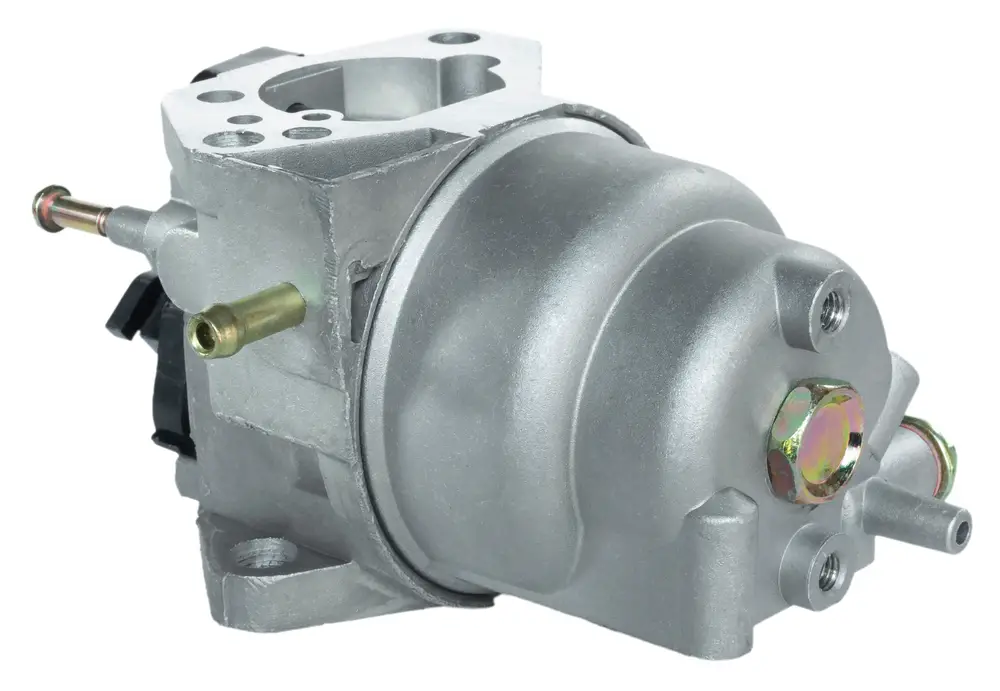
Your lawn mower’s carburetor delivers fuel to the engine based on how far the throttle is pulled. Too much pull could flood the engine.
In addition, when starting the lawn mower, the choke will close valves to allow more fuel into the engine chambers. This makes the lawn mower easier to start. However, sometimes the valves remain shut and cause sputtering.
Lastly, if your lawn mower’s carburetor has too much trash or gunk buildup, it will blow fuel flow and cause sputtering.
What To Do
Try using carburetor cleaner on your carburetor. Spray it in and around the carburetor’s body. If this doesn’t work, unless you’re experienced enough to fix your carburetor, we recommend taking your lawn mower into the shop.
5 – Low Fuel
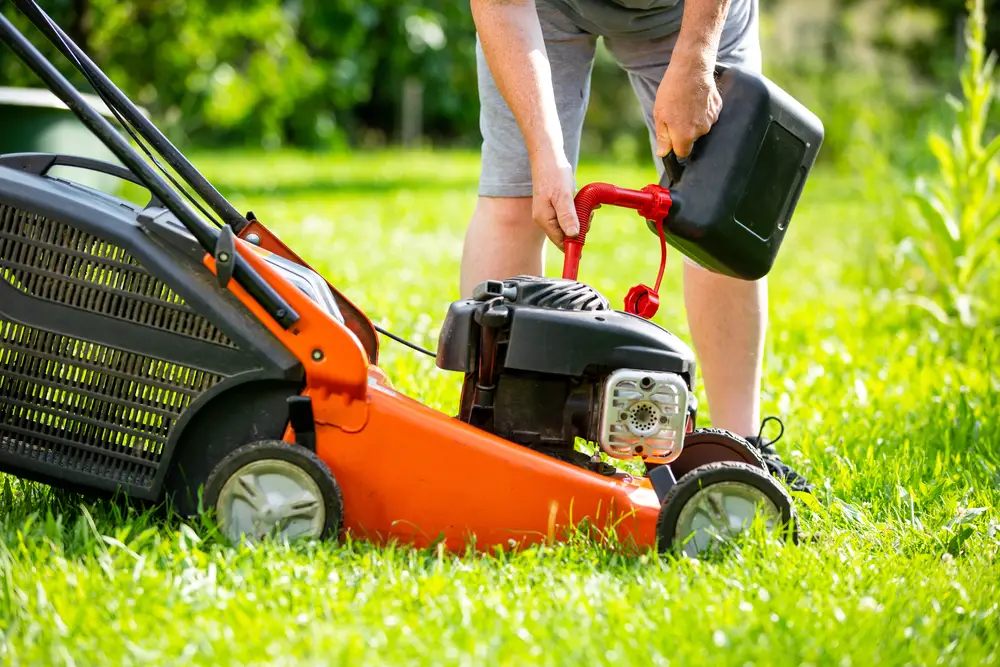
Your lawn mower will sputter while low on fuel. Your lawn mower will die when it runs out of fuel.
What To Do
Refill your lawn mower’s fuel if you’re using gas. Never let your lawn mower run out of fuel if you’re using diesel.
6 – Fuel Contaminated With Water

Water extensively damages your lawn mower’s engine when it gets into the fuel (usually from rain or poor fuel stations). This will cause sputtering and can even completely ruin your lawn mower.
What To Do
Try a water-removing fuel treatment first. If this doesn’t work, take your lawn mower to the shop. There is a high chance you will need to replace it, though.
7 – Cutting Difficult Grass

Sometimes your grass gets long or thick enough that it causes your lawn mower to sputter. In this case, you’ll need to make some adjustments to solve the issue.
What To Do
You have a few options when dealing with difficult grass.
Your first option is to keep the throttle high on the rabbit, in the lowest gear, and start your blades before reaching the difficult grass.
Your second option is to raise your cutting deck on your first pass, then lower it on an additional pass.
Hire someone with a bush hog if your lawn mower is still struggling.
8 – Exhaust System Blockages
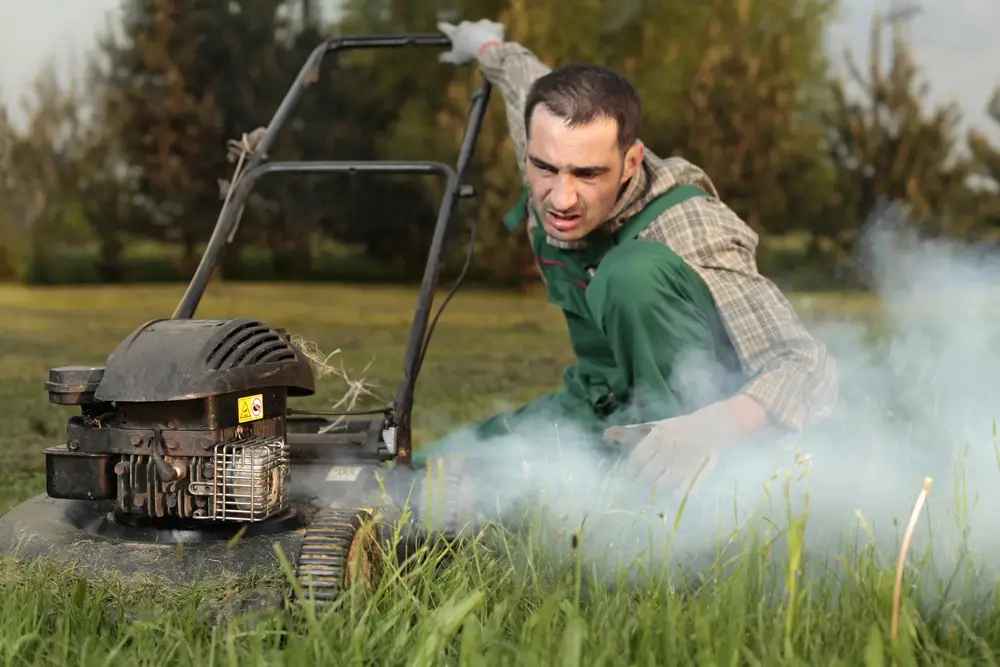
As air flows into your lawn mower, it also must flow out, courtesy of the exhaust system. If anything is obstructing this system, your lawn mower will sputter.
What To Do
If something is clogging your exhaust, wait until your lawn mower is off and cool. Unclog your exhaust and try running your lawn mower again. Contact a professional if the sputtering continues.
9 – Failure To Keep Up With Maintenance
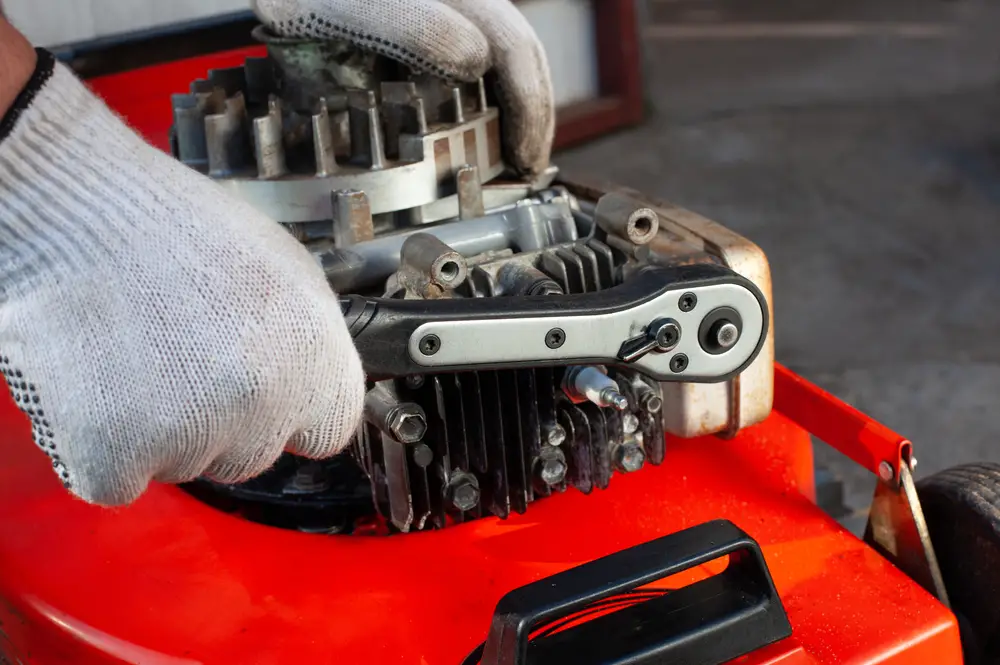
Failure to perform maintenance on a lawn mower will cause breakdowns, sputtering, more significant wear and tear, and other problems. Maintenance consists of the following:
- Changing the oil and filter every 50 hours
- Changing the air filter every 75 hours or once a year
- Consistently keeping the blades sharp (replace them if needed)
- Checking the belts regularly
- Maintaining the proper amount of air in the tires
- Keeping your lawn mower clean
Consult your owner’s manual for performing these tasks and any special maintenance required.
What To Do
The best way to keep up with lawn mower maintenance is to create a checklist and mark it on the calendar when the task is due. Keep the checklist and due dates somewhere where you will always see them around the lawn mower storage area. It will remind you to take care of your lawn mower’s needs.
10 – Weak Battery

A weak battery causes your lawn mower’s electrical system to slow until it shuts down. While running, your lawn mower burns more fuel and sputters. In many cases, your lawn mower will fail to start once it dies.
A weak or dead battery is a critical problem requiring immediate fixing.
What To Do
Test your battery with a battery tester/charger before replacing it. Sometimes your battery will get low due to cold weather or not using your lawn mower for an extended period.
Consult your lawn mower to locate your lawn mower’s battery. After, put the black clamp (negative) from the tester/charger on the black connection on your battery, then the red (positive) on the red. Plug the tester/charger in and switch it on.
All testers are different, so read your tester’s owner manual to determine what the reading means. If the battery is weak, switch it over to the charging 12-volt side and let it charge overnight unless the charger only charges for four, six, or eight hours (you can also try using your car as a last resort option).
When the charger is done, turn it off and unplug it. Disconnect the red clamp first, then the black one. The lawn mower should start after the charge; if not, you must replace the battery.
You will need tools to fit the connection bolts for the positive and negative sides. Find the right size to fit the connections and remove the positive wire (+) first, then the negative (-). Remove the bolt at the bottom of the battery holding it in place. You may need a flashlight to find it.
Pull the old battery out and replace it with the new one. Put the bolt at the bottom of the battery back on and put the negative wire on first, then the positive. Double-check to make sure the connections are tight.
Preventive Measures To Maintain A Smooth Lawn Mower
Maintenance is number one, but other preventive measures include inspecting before starting your lawn mower. Many different fuel treatments and stabilizer brands keep the internal components working like new ones.
How you store your lawn mower also makes a difference over time. Keep it in dry, enclosed areas out of the weather and sun.
At the sign of any issues with your lawn mower, look into them and fix them right away. Not doing so can result in more significant issues down the road.
My Experience With A Sputtering Lawn Mower
The sounds of a sputtering lawn mower are funny until you get the repair bill. I remember we lost the storage place for our lawn mower after a storm took our shed. The lawn mower sat outside, and eventually, water mixed with the fuel before we could replace the shed.
It sounded funny, but the lawn mower was no good after the water rusted out the internal components within no time. I not only had the repair bill, but I also had to purchase a new lawn mower.
I hope such a situation never happens to you.
